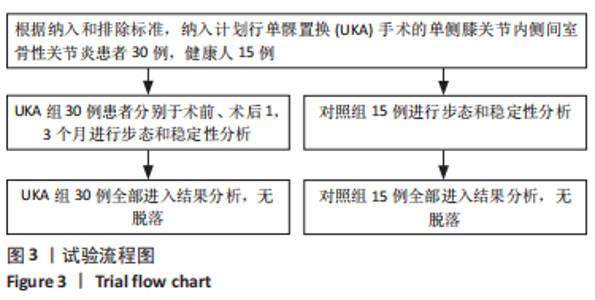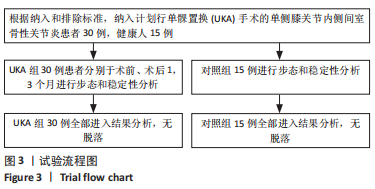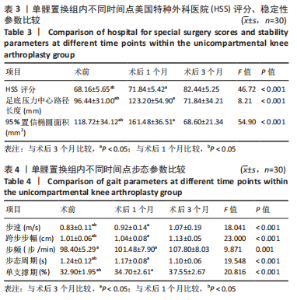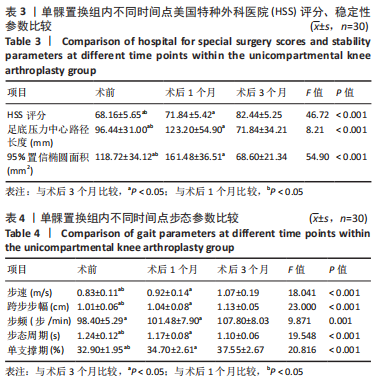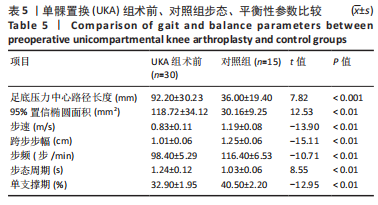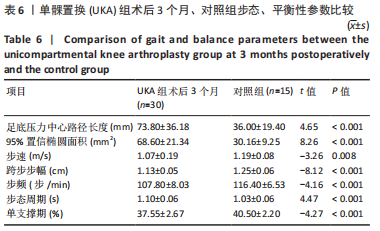Chinese Journal of Tissue Engineering Research ›› 2024, Vol. 28 ›› Issue (12): 1875-1879.doi: 10.12307/2024.024
Previous Articles Next Articles
Stability of early gait after unicompartmental knee arthroplasty
Gu Xu1, 2, Zheng Xin2, Shi Sifeng2, Lu Renxiang1, 2, Cao Jie1, 2, Li Hongwei2
- 1Graduate School, Xuzhou Medical University, Xuzhou 221006, Jiangsu Province, China; 2Department of Orthopedics, Affiliated Hospital of Xuzhou Medical University, Xuzhou 221006, Jiangsu Province, China
-
Received:2022-11-22Accepted:2023-02-22Online:2024-04-28Published:2023-08-22 -
Contact:Li Hongwei, MD, Chief physician, Master’s supervisor, Department of Orthopedics, Affiliated Hospital of Xuzhou Medical University, Xuzhou 221006, Jiangsu Province, China -
About author:Gu Xu, Master candidate, Physician, Graduate School, Xuzhou Medical University, Xuzhou 221006, Jiangsu Province, China; Department of Orthopedics, Affiliated Hospital of Xuzhou Medical University, Xuzhou 221006, Jiangsu Province, China -
Supported by:Young Medical Talents of Jiangsu Province’s “Science and Education Strengthening Health Project”, No. QNRC2016801 (to ZX); Xuzhou City Promotion Science and Technology Innovation Project, No. KC19063 (to ZX)
CLC Number:
Cite this article
Gu Xu, Zheng Xin, Shi Sifeng, Lu Renxiang, Cao Jie, Li Hongwei. Stability of early gait after unicompartmental knee arthroplasty[J]. Chinese Journal of Tissue Engineering Research, 2024, 28(12): 1875-1879.
share this article
Add to citation manager EndNote|Reference Manager|ProCite|BibTeX|RefWorks
| [1] WILSON HA, MIDDLETON R, ABRAM SGF, et al. Patient relevant outcomes of unicompartmental versus total knee replacement: systematic review and meta-analysis. BMJ. 2019;364:l352. [2] BANNURU RR, OSANI MC, VAYSBROT EE, et al. OARSI guidelines for the non-surgical management of knee, hip, and polyarticular osteoarthritis. Osteoarthritis Cartilage. 2019;27(11):1578-1589. [3] 边焱焱, 程开源, 常晓, 等. 2011至2019年中国人工髋膝关节置换手术量的初步统计与分析[J]. 中华骨科杂志,2020,40(21):1453-1460. [4] Vissers MM, de Groot IB, Reijman M, et al. Functional capacity and actual daily activity do not contribute to patient satisfaction after total knee arthroplasty. BMC Musculoskelet Disord. 2010;11:121. [5] Bach CM, Nogler M, Steingruber IE, et al. Scoring systems in total knee arthroplasty. Clin Orthop Relat Res. 2002;(399):184-196. [6] 李远栋, 刘爱峰, 张君涛, 等. 步态分析在膝关节骨性关节炎中的应用研究进展[J]. 国际生物医学工程杂志,2020,43(1):75-79. [7] 吴东, 杨敏之, 曹正, 等. 膝关节单髁置换术研究进展[J]. 中国修复重建外科杂志,2020,34(2):145-150. [8] Chang A, Hurwitz D, Dunlop D, et al. The relationship between toe-out angle during gait and progression of medial tibiofemoral osteoarthritis. Ann Rheum Dis. 2007;66(10):1271-1275. [9] 张启栋, 郭万首, 刘朝晖, 等. 内翻畸形膝骨关节炎软骨磨损的临床研究[J]. 中国矫形外科杂志,2013,21(23):2345-2350. [10] Kim KT, Lee S, Lee JI, et al. Analysis and Treatment of Complications after Unicompartmental Knee Arthroplasty. Knee Surg Relat Res. 2016;28(1):46-54. [11] El-Galaly A, Kappel A, Nielsen PT, et al. Revision Risk for Total Knee Arthroplasty Converted from Medial Unicompartmental Knee Arthroplasty: Comparison with Primary and Revision Arthroplasties, Based on Mid-Term Results from the Danish Knee Arthroplasty Registry. J Bone Joint Surg Am. 2019;101(22):1999-2006. [12] Kahlenberg CA, Richardson SS, Gruskay JA, et al. Trends in Utilization of Total and Unicompartmental Knee Arthroplasty in the United States. J Knee Surg. 2021;34(10):1138-1141. [13] Kuo AC, Giori NJ, Bowe TR, et al. Comparing Methods to Determine the Minimal Clinically Important Differences in Patient-Reported Outcome Measures for Veterans Undergoing Elective Total Hip or Knee Arthroplasty in Veterans Health Administration Hospitals. JAMA Surg. 2020;155(5):404-411. [14] 邬波, 柳椰, 杜明昌, 等. 膝关节单髁置换治疗膝内侧间室骨关节炎的疗效观察[J]. 中华骨与关节外科杂志,2017,10(2):123-125,131. [15] Khanna G, Singh JA, Pomeroy DL, et al. Comparison of patient-reported and clinician-assessed outcomes following total knee arthroplasty. J Bone Joint Surg. 2011;93(20):e117. [16] Studenski S, Perera S, Patel K, et al. Gait speed and survival in older adults. JAMA. 2011;305(1):50-58. [17] 瞿晓娜, 张腾宇, 王喜太, 等. 行走速度对步态参数影响的实验研究[J]. 中国康复医学杂志,2012,27(3):257-259. [18] McKean KA, Landry SC, Hubley-Kozey CL, et al. Gender differences exist in osteoarthritic gait. Clin Biomech (Bristol, Avon). 2007;22(4):400-409. [19] Casartelli NC, Item-Glatthorn JF, Bizzini M, et al. Differences in gait characteristics between total hip, knee, and ankle arthroplasty patients: a six-month postoperative comparison. BMC Musculoskelet Disord. 2013;14:176. [20] 柯鹏辉, 尹宗生, 陆鸣, 等. 单髁与全膝关节置换术后步态与平衡能力比较[J]. 中华关节外科杂志(电子版),2020,14(1):11-16. [21] Nha KW, Shon OJ, Kong BS, et al. Gait comparison of unicompartmental knee arthroplasty and total knee arthroplasty during level walking. PloS One. 2018;13(8):e0203310. [22] 郭甲瑞. 单髁与全膝关节置换术对单侧膝骨关节炎患者步态和运动学参数影响研究[J]. 人民军医,2021,64(4):318-320. [23] Kim MK, Yoon JR, Yang SH, et al. Unicompartmental knee arthroplasty fails to completely restore normal gait patterns during level walking. Knee surg Sports Traumatol Arthrosc. 2018;26(11):3280-3289. [24] 中国老年保健医学研究会老龄健康服务与标准化分会, 《中国老年保健医学》杂志编辑委员会. 中国老年人跌倒风险评估专家共识(草案) [J]. 中国老年保健医学,2019,17(4):47-48,50. [25] 徐欣, 温子星. 人体动态稳定性控制理论在老年人防跌倒中的应用[J]. 中国康复理论与实践,2017,23(11):1254-1257. [26] Baumann F, Bahadin O, Krutsch W, et al. Proprioception after bicruciate-retaining total knee arthroplasty is comparable to unicompartmental knee arthroplasty. Knee Surg Sports Traumatol Arthrosc. 2017;25(6):1697-1704. [27] Zhang W, Low LF, Schwenk M, et al. Review of Gait, Cognition, and Fall Risks with Implications for Fall Prevention in Older Adults with Dementia. Dement Geriatr Cogn Disord. 2019;48:17-29. [28] Henry M, Baudry S. Age-related changes in leg proprioception: implications for postural control. J Neurophysiol. 2019;122(2):525-538. [29] Schultz RA, Miller DC, Kerr CS, et al. Mechanoreceptors in human cruciate ligaments. A histological study. The Journal of bone and joint surgery. J Bone Joint Surg Am. 1984;66(7):1072-1076. [30] Zhang C, Sun W, Yu B, et al. Effects of exercise on ankle proprioception in adult women during 16 weeks of training and eight weeks of detraining. Res Sports Med. 2015;23(1):102-113. [31] Sadeghi H, Hakim MN, Hamid TA, et al. The effect of exergaming on knee proprioception in older men: A randomized controlled trial. Arch Gerontol Geriatr. 2017;69:144-150. [32] Soleimani R, Jalali MM, Mirbolook AR. Predictors of Fear of Falling among Iranian Older Adults with Hip Fracture and Controls. Clin Gerontol. 2020;43(4):391-399. [33] Mueller MJ, Maluf KS. Tissue adaptation to physical stress: a proposed “Physical Stress Theory” to guide physical therapist practice, education, and research. Phys Ther. 2002;82(4):383-403. [34] Fetzer GB, Callaghan JJ, Templeton JE, et al. Posterior cruciate-retaining modular total knee arthroplasty: a 9- to 12-year follow-up investigation. J Arthroplasty. 2002;17(8):961-966. |
| [1] | Li Yongjie, Fu Shenyu, Xia Yuan, Zhang Dakuan, Liu Hongju. Correlation of knee extensor muscle strength and spatiotemporal gait parameters with peak knee flexion/adduction moment in female patients with knee osteoarthritis [J]. Chinese Journal of Tissue Engineering Research, 2024, 28(9): 1354-1358. |
| [2] | Du Changling, Shi Hui, Zhang Shoutao, Meng Tao, Liu Dong, Li Jian, Cao Heng, Xu Chuang. Efficacy and safety of different applications of tranexamic acid in high tibial osteotomy [J]. Chinese Journal of Tissue Engineering Research, 2024, 28(9): 1409-1413. |
| [3] | Huang Xiarong, Hu Lizhi, Sun Guanghua, Peng Xinke, Liao Ying, Liao Yuan, Liu Jing, Yin Linwei, Zhong Peirui, Peng Ting, Zhou Jun, Qu Mengjian. Effect of electroacupuncture on the expression of P53 and P21 in articular cartilage and subchondral bone of aged rats with knee osteoarthritis [J]. Chinese Journal of Tissue Engineering Research, 2024, 28(8): 1174-1179. |
| [4] | Chen Zan, Lei Fei, Ye Fei, Zhou Qingzhong, Yuan Hao, Zheng Lipeng, Zha Xian, Feng Daxiong. Relationship between drainage time and early efficacy after short-segment lumbar fusion [J]. Chinese Journal of Tissue Engineering Research, 2024, 28(6): 927-933. |
| [5] | Zhang Zeyi, Yang Yimin, Li Wenyan, Zhang Meizhen. Effect of foot progression angle on lower extremity kinetics of knee osteoarthritis patients of different ages: a systematic review and meta-analysis [J]. Chinese Journal of Tissue Engineering Research, 2024, 28(6): 968-975. |
| [6] | Shen Feiyan, Yao Jixiang, Su Shanshan, Zhao Zhongmin, Tang Weidong. Knockdown of circRNA WD repeat containing protein 1 inhibits proliferation and induces apoptosis of chondrocytes in knee osteoarthritis [J]. Chinese Journal of Tissue Engineering Research, 2024, 28(4): 499-504. |
| [7] | Chen Modi, Sun Qibo, Xu Tianyu, Tai Guoliang, Zhao Yuxiang, Pan Zhaohui. Biomechanics of reconstruction of total calcaneus defect using fibular flap based on finite element method [J]. Chinese Journal of Tissue Engineering Research, 2024, 28(12): 1805-1809. |
| [8] | Zhang Huizhen, Wu Wei, Luo Haitao. Medium to low intensity exercise interferes with the expression of LncRNA HOTAIR in chondrocytes in high-fat-fed mice with knee joint damage [J]. Chinese Journal of Tissue Engineering Research, 2024, 28(11): 1684-1689. |
| [9] | Zeng Jiaxu, He Qi, Chen Bohao, Li Miao, Li Shaocong, Yang Junzheng, Pan Zhaofeng, Wang Haibin. An insight into the mechanism of iron overload in knee osteoarthritis under the theory of blood stasis [J]. Chinese Journal of Tissue Engineering Research, 2024, 28(11): 1743-1748. |
| [10] | Mo Jian, Ye Sentao, Zhang Xiaoyun. Progress in the treatment of knee osteoarthritis with monomer and compound Chinese medicine [J]. Chinese Journal of Tissue Engineering Research, 2024, 28(11): 1756-1761. |
| [11] | Yan Wei, Kong Bo, Xi Xiaobing, Xu Yong, Jia Youji, Ruan Beite, Zhang Jiahui, Ma Honghong, Li Zhongwei. Compound cottonrose hibiscus leaf gel plaster of optimal “Xiaozhongsan” formulation for knee synovitis [J]. Chinese Journal of Tissue Engineering Research, 2024, 28(10): 1580-1585. |
| [12] | Shen Feiyan, Yao Jixiang, Su Shanshan, Zhao Zhongmin, Tang Weidong. Knockdown of circRNA WD repeat containing protein 1 inhibits proliferation and induces apoptosis of chondrocytes in knee osteoarthritis [J]. Chinese Journal of Tissue Engineering Research, 2023, 27(在线): 1-6. |
| [13] | Li Xiaomin, Tian Xiangdong, Tan Yetong, Zhu Guangyu, Wang Rongtian, Wang Jian, Xue Zhipeng, Ma Sheng, Hu Yuanyi, Huang Ye, Ding Tiansong. Changes of lower limb force line and knee function after high tibial osteotomy in osteoporotic medial ventricular knee osteoarthritis [J]. Chinese Journal of Tissue Engineering Research, 2023, 27(9): 1325-1329. |
| [14] | Yu Wenqiang, Ren Fuchao, Shi Guohong, Xu Yuanjing, Liu Tongyou, Xie Youzhuan, Wang Jinwu, . Methods and application of gait analysis of lower limbs after stroke [J]. Chinese Journal of Tissue Engineering Research, 2023, 27(8): 1257-1263. |
| [15] | Cui Lianxu, Jiang Wenkang, Lu Dahong, Xu Junrong, Liu Xiaocui, Wang Bingyun. Clinical-grade human umbilical cord mesenchymal stem cells affect the improvement of neurological function in rats with traumatic brain injury [J]. Chinese Journal of Tissue Engineering Research, 2023, 27(6): 835-839. |
| Viewed | ||||||
|
Full text |
|
|||||
|
Abstract |
|
|||||
